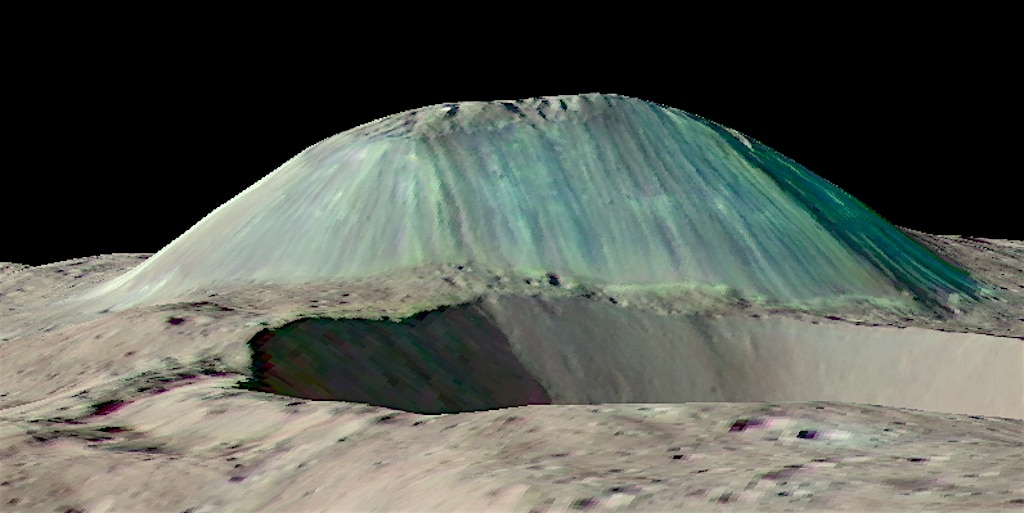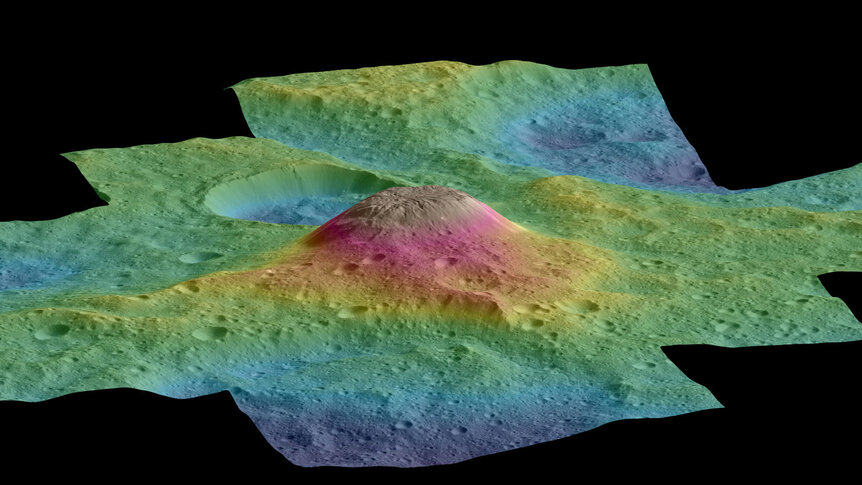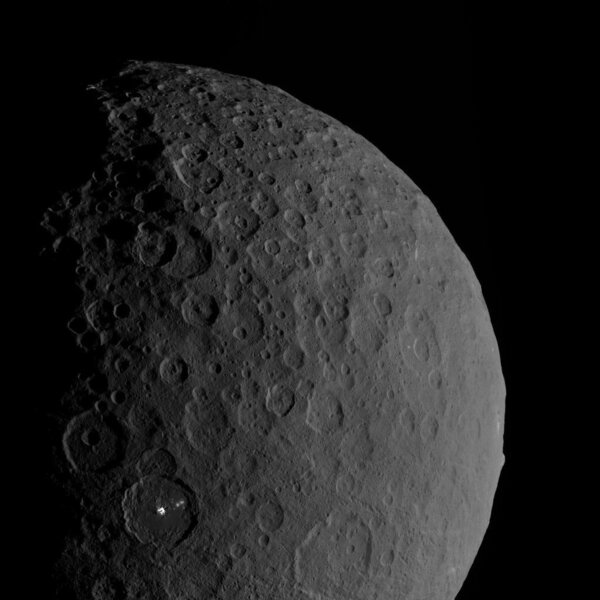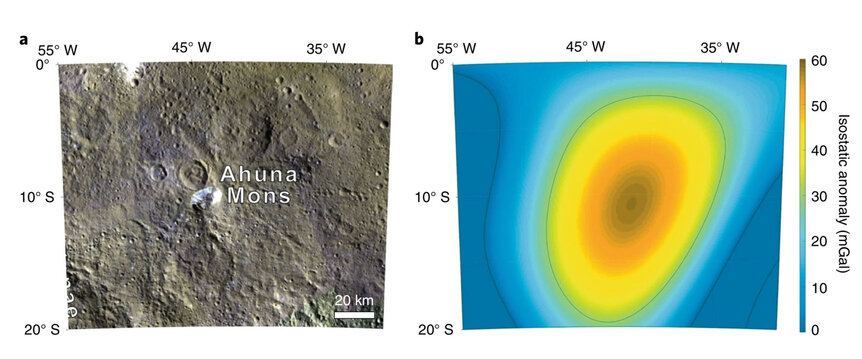Create a free profile to get unlimited access to exclusive videos, sweepstakes, and more!
Ahuna Mons: A muddy, icy volcano on Ceres

Ceres is the largest object in the asteroid belt, the band of rubble orbiting the Sun between Mars and Jupiter. At nearly 1,000 kilometers wide, it’s technically a protoplanet — something that was on its way to becoming a full-fledged planet before it ran out of material to feed on and grow. That was over 4 billion years ago, so you might expect it to be a dead, frozen world now, with nothing new happening on it geologically speaking except for possibly the odd asteroid impact or two.
But the one thing the Universe does well is pervert our expectations. When the Dawn spacecraft arrived at Ceres in 2015, it did indeed see a world scarred by impacts. But it also saw two very, very strange things. One was a series of bright reflective patches scattered across the surface, usually in craters, and easy to spot in contrast to the generally very dark gray surface.
The other was Ahuna Mons.
This is an oblong mountain sticking out of the side of the protoplanet, 17 km across at its base and stretching over 4 kilometers high into the airless sky. It’s flat-topped, like a mesa, with long angled flanks surrounding it like a skirt. There’s nothing else like it on Ceres, and with the exception of a single adjacent crater, the terrain around it is relatively flat and devoid of any structures. Ahuna Mons literally stands alone.
And that’s weird. Ceres has no tectonic activity, so it can’t grow mountains that way. That usually forms mountain chains, anyway (like the continental plate collisions on Earth that created the Rocky Mountains and the Himalayas).
That only leaves one other explanation: Upwelling. Literally something under the surface trying its best to get out.
This isn’t a new idea, and in fact it was proposed right after Ahuna Mons was first spotted. It was thought to be some sort of cryovolcano — literally, a volcano that is fueled by water (yes, water) instead of molten rock — but the details were unclear. New research, though, has refined the idea quite a bit, and has even been able to zero in on the material doing the upwelling: Not just water, but also lots of rocky particles suspended in it.
So: Mud.
How is this possible?
Ceres isn’t like other asteroids. It was big enough when it first formed to have partially differentiated, meaning that when it was still hot heavier stuff like rock and some metals fell to the center, while lighter stuff like water, aluminum-rich material, and some lower density rock remained farther out. Eventually it cooled, forming a crust roughly 40 km thick on average over an icy mantle about 400 km deep. Measurements by Dawn indicated the mantle is roughly twice as dense as the crust (1.3 grams per cubic centimeter versus 2.4, where water has a density of 1). Not only that, but the decay of the small amount of radioactive material inside Ceres can warm it enough that water deep below the surface could still be liquid, even after all this time.
Much of the water in the mantle is liquid, and stuff near the bottom of the mantle will be warmer than stuff near the top. That means the water will convect, with warmer stuff rising and cooler stuff falling. If there’s enough pressure from below, water forces its way up and through the surface, upwelling through cracks.
A lot of rock and such is dissolved in the water, making it briny. When it hits the surface it freezes and sunlight eventually turns it into a gas. It evaporates (technically, it sublimes), leaving behind the brine: That is what makes the bright spots we see all over Ceres.
Sometimes, though, the water rises in a plume, like the one that is making the Canary and Hawaiian islands. That actually fits the data better, and the authors think this may be what’s happening under the surface to create Ahuna Mons.
By itself this might not penetrate the surface. However, if it found a spot in the crust that’s thinner, and there’s a conduit in the crust even just 10 meters across, that could explain what’s seen. The water getting to the surface freezes, but more water comes up from the plume, pushing that ice up and up. It eventually forms a mountain, essentially a slow volcano. It doesn’t have much structural strength, so it collapses along the sides, forming the skirt.
The new work uses a clever method to figure out what material is in Ahuna Mons. Dawn’s orbit depended on the overall mass of Ceres (that’s how gravity works), but if Dawn passed over a local region with higher density it would speed up. By carefully measuring the Doppler shift of the radio signals it sent back to Earth, scientists can precisely measure the spacecraft’s orbit, and therefore the density of the material underneath it at any given time.
Measuring the gravity of Ceres, they found an anomaly right at the position of Ahuna Mons. Using some physics to fit computer models to the gravity, they found that the best fit was with a blob of material about 80 x 40 km in size and 30 km in depth. The density of the material was about 2.4 grams/cc, which matches the mantle density. That clinches the idea that this is some blob from the mantle welling up through the surface (probably where the curst was less thick, since it averages 40 km deep).
Examining the morphology of Ahuna Mons, the physics of how material moves around inside Ceres, and what happens as it cools, they find that the material was 55 – 70% water by volume, with the remaining 30 – 45% “non-soluble, solid particles, in essence a slurry”.
In other words, mud.
This could explain why Ahuna Mons is the only mountain of its kind, too; plumes won’t be common, especially near places where the crust is thinner. And if any others did form they’d probably slump and collapse over some tens or hundreds of millions of years. Which also means Ahuna Mons is young, in a geological sense. It’s entirely possible the plume is still active now. That might take a while to know, though, perhaps by seeing if there are any landslides happening now as material gets pushed up.
Sadly, Dawn ran out of fuel in late 2018, and so science observations have stopped. Hopefully we’ll send another probe to this weird little world to see what’s what…. and what’s changed since Dawn. I love how we keep getting surprised by our solar system, which defies expectations at every turn. But as the saying goes, if we knew what we’d find out there, it wouldn’t be exploration.





























